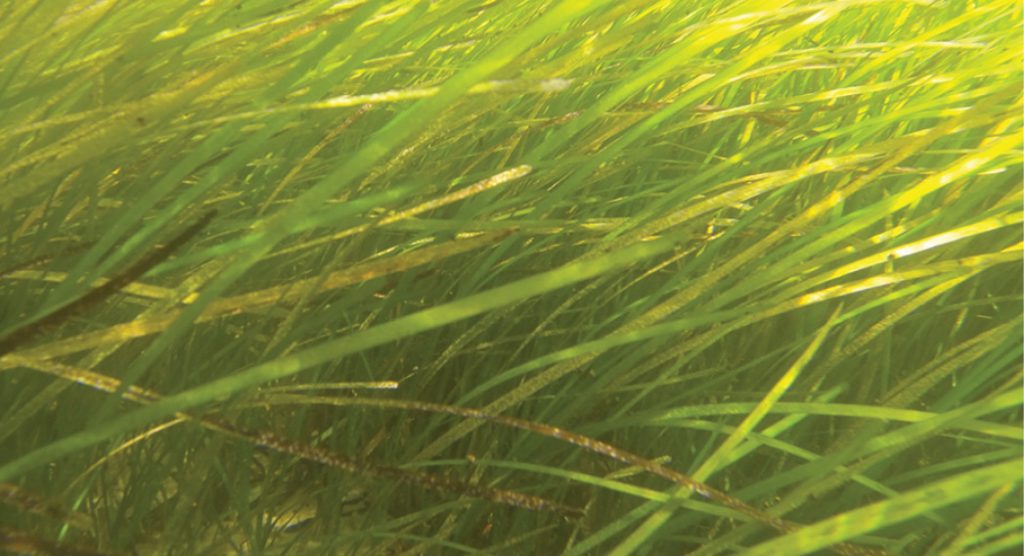By Connor Jones, FISM Project Manager

A vital part of the Long Island Sound ecosystem, eelgrass meadows are under threat from human activities. © Emily Bodell
Seagrasses are under intense pressures globally, and these pressures are particularly acute in Long Island Sound. Historically, eelgrass (Zostera marina) – the predominant species of seagrass found in the Sound – was so abundant, it was harvested for insulation and fertilizer; but today, fewer than 1,500 acres remain. A number of threats have caused this decline in the extent of eelgrass beds. The meadows that persist are threatened by eutrophication processes when excess nitrogen – from wastewater and fertilizers – flows into the Sound, fueling the growth of harmful algae that kill fish, threaten human health and block the sunlight seagrasses need to photosynthesize. Sediment that washes into the water from coastal construction and erosion can bury eelgrass and create turbidity that also blocks sunlight, further hampering their survival. Climate change is also a threat, both in rising water temperatures and in extreme weather events that can produce damaging wave energy for the beds. Finally, boating and dredging activity can rip eelgrass from the sediment.
Since the 1930s, the extent of eelgrass in Long Island Sound has declined by 90%. One quarter of the remaining eelgrass (350 acres) is located in the waters around Fishers Island. These meadows comprise 98% of the eelgrass remaining in the New York waters of the Sound. While it may seem prevalent here, Fishers Island’s eelgrass meadows are also at risk – the most recent survey indicates a 14% decline occurred between 2012 and 2017.
Eelgrass meadows provide a number of ecosystem services and as a result are one of the planet’s most valuable ecosystems. A species of flowering plant, eelgrasses oxygenate the water as they carry out photosynthesis. Meadows provide habitat for numerous ecologically and economically important fish and shellfish species such as lobster, striped bass, summer flounder, bay scallops and sea turtles. Eelgrass meadows dampen wave energy, which in turn prevents beach erosion. Protecting eelgrass is an important part of mitigating the effects of climate change – eelgrasses are very efficient (even more so than tropical forests) at capturing and storing carbon. Along with carbon, eelgrasses also trap sediments within their root systems, thus improving water quality. Given that Fishers Island’s eelgrass ecosystem supports healthy marine systems, protects our coastal shorelines, and helps sustain our community’s connection between the environment and our quality of life, this current decline is cause for concern.
To address these issues, the Fishers Island Seagrass Management (FISM) Coalition was formed in 2017, bringing together a variety of stakeholders with direct or indirect interactions with Fishers Island’s seagrass habitats. The FISM Coalition’s mission is to promote community learning about eelgrass meadows and how to protect, sustain and care for them; strengthen productive collaborative relationships among stakeholders, both within and outside the community; and foster the protection and effective management of this important resource and the benefits it provides Fishers Island and the region. The goal of the coalition is to establish a co-management of the island’s seagrass meadows, one in which the island community and the state would share seagrass management authority and responsibility.
The Coalition has been engaging in community outreach and education to spread the word about the importance of seagrass, and how people can protect it through actions in their everyday lives. This year, the Coalition has been distributing two physical pieces of educational material to the island community as well as coastal communities in neighboring states. The first is a postcard aimed at educating boaters on ways to minimize their impact on seagrass. This includes trimming up your prop in shallow water and anchoring outside of seagrass meadows. The second is a tri-fold brochure that focuses on the impact fertilizers and lawn care products have on coastal waters. Reducing excess nutrient runoff from the land is a great way to ensure that our coastal waters stay clean and usable. Even a few adjustments to your lawn and garden care routine can have positive impacts on coastal ecosystems. You can view these materials, and other helpful resources, on the “Seagrass Safe Boating” and “Seagrass Safe Lawn Care” pages of the Coalition’s website, fiseagrass.org.
This past spring, Coalition members were trained to use SeaSketch, a web-based platform with tools designed to support collaborative ocean planning. SeaSketch will also help the Coalition take into account the goals of different users of these areas so that the needs of commercial and recreational users are met. Throughout the fall, the Coalition will continue to use SeaSketch to create potential Seagrass Management Areas (SMAs) and further develop a Seagrass Management Plan. The Coalition will narrow potential options through a review process that includes meetings, webinars and workshops with the Coalition, the town of Southold and the New York State Department of Environmental Conservation (DEC). To view the Coalition’s SeaSketch project page, visit fism.seasketch.org.
To view a calendar of upcoming meetings and events, visit the “News, Events & Blog Posts” page on the Coalition website, fiseagrass.org. We will be posting the dates of these meetings on our website. Any questions regarding these activities and our planning process can be directed at the FISM Project Coordinator, Connor Jones (fishersislandseagrass@gmail.com). ■
